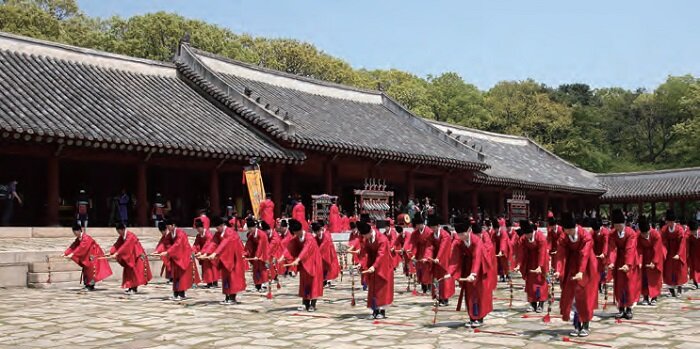Contemporary Art
It seems that Korean contemporary art is becoming more and more recognized as Korean artists have steadily achieved meaningful results on the global stage.
Korean-born video artist Nam June Paik, who passed away in 2006, is considered the father of contemporary video art. Dansaekhwa masters Lee Ufan, Ha Chong-hyun, and Park Seo-bo are attracting attention from major collectors around the world. Park Seo-bo’s Ecriture series of paintings were successfully exhibited at the Guggenheim Museum in New York in 2020.
Yang Hye-kyu is a world-renowned contemporary artist who works in Seoul and Berlin and whose practice spans a wide range of media from paper collage to performative sculpture and large-scale multi-sensorial installation. She ranked 36th in the 2019 Power 100 List announced by ArtReview, the world’s leading international contemporary art magazine in the United Kingdom. Currently, she has been actively engaged in her solo exhibitions in the US, Canada, the UK, and other countries.
Works of prominent contemporary artists can be enjoyed in Insa-dong and Samcheongdong in Seoul, where many art galleries are located, such as Insaart Center, Gongpyeong Art, and the Kyung-in Museum of Fine Art. Recently, more art galleries have been opening in Cheongdam-dong and Hannam-dong in Seoul.
Various contemporary art festivals are held in South Korea. Among wellknown art festivals is the Gwangju Biennale, a contemporary art biennale, which was first held in 1995.
Contemporary Literature
In recent years, Korean literature, especially including Korean novels, has been recognized in the international literary world for its potential for global themes.
This change was made possible because of the achievements made by writer Shin Kyung-sook in 2011 and writer Han Kang in 2016.
Han Kang’s novel entitled The Vegetarian won the 2016 Man Booker International Prize, which is regarded as one of the world’s three most prestigious literary awards. Her other book Human Acts also won the 2017 Malaparte Prize, Italy’s authoritative literary award.
As for Shin Kyung-sook, the English-translated version of her novel entitled Please Look After Mom entered the top 10 in the Amazon best-sellers rank upon its release in the United States. Subsequently, this book was promptly translated and published in about 30 countries in Asia (including Japan) and Europe, and in Australia.
Thanks to these splendid feats, the number of Korean literature works published overseas has increased significantly every year: 69 in 2017, 74 in 2018,and 91 in 2019.
The popularity of Korean literature can be analyzed in many aspects. Most of all, the narrative style that dissolves global social issues into the characters’ personal history can be seen to resonate with the readers. A representative example is Kim Ji-young Born 1982, a fiction novel by Cho Nam-joo, which is labeled a feminist novel. Along with the exportation of the copyright to 18 countries, 80,000 copies were sold in just two months after its release in Japan in 2018, becoming the best-seller in the Asian literature category except for Japan and China. Thanks to the popularity of the novel, its movie adaptation was released in South Korea with the same title.
In addition, a variety of works by different Korean artists, ranging from senior artists such as Park Wan-suh and Hwang Sok-yong to young artists such as Chang Kang-myoung and Jung Eun-young, are being vigorously introduced overseas.
Korean Cuisine and Culinary Customs
The Korean Wave is expanding into other cultural areas such as food and culinary traditions. Restaurants serving traditional Korean dishes began to open in the world’s largest metropolises such as New York, London, and Paris, attracting praise even from the choosiest gourmets. Kimchi, bulgogi, bibimbap, and other dishes loved by Korean people through many generations are now beginning to appear in homes around the world.
Chefs in some restaurants in the United States have combined traditional Korean dishes with Western traditions, creating the bibimbap burger, kimchi hotdog, and gochujang steak for New Yorkers.
Interestingly, Korean cuisine is recognized as a well-being diet, not just out of curiosity, but in line with the global trend in preferring healthy food. Korean cuisine consists of a properly balanced diet of carbohydrates, proteins, and fats and ensures a sufficient intake of vitamins and minerals through vegetable side dishes. In recognition of these merits, the World Health Organization (WHO) selected Korean cuisine as a nutritionally well-balanced model in 2004. USA Today, a US general-interest newspaper, selected kimchi, along with Vietnamese rice noodles and cabbage, in its prediction of most popular foods in 2020.
While Koreans and other Asians largely visited Korean restaurants in the past, locals now account for more than half of the customers at Korean restaurants. A survey reported that bibimbap and bulgogi are the most popular dishes in Korean restaurants in Paris, and bibimbap, in particular, is further recognized as a vegetable-oriented well-being food.
Recently, more people have tried to make their own Korean dishes by following the recipes on Korean cooking channels on YouTube.



















